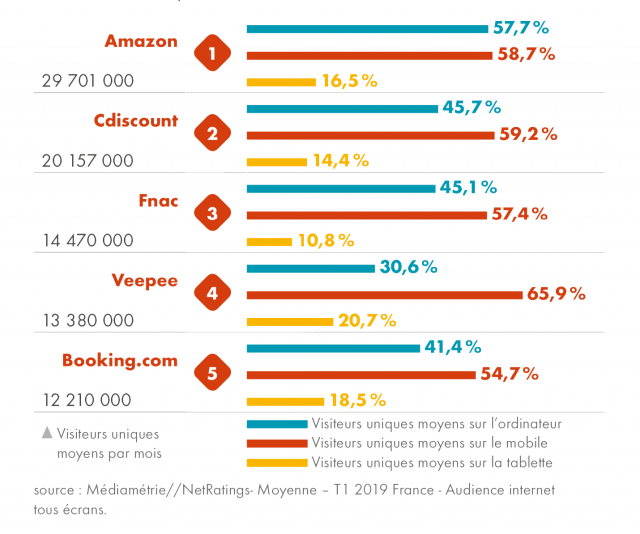Marketplaces currently occupy a predominant place in the e-commerce world. In France, no less than 43 million Internet users have consulted at least one of the 15 main merchant sites each month. With, in the lead: Amazon, Ebay, Cdiscount, Fnac, Vente – Privée, etc. (Source Fevad: Quarterly barometer of May 2019)
Top 5 of the most visited sites & applications in France
It is in this perspective of gaining visibility that most e-merchants have undertaken to sell their products via this distribution channel.
However, and apart from this strong gain in visibility, selling on a marketplace can bring to your company other advantages often overlooked by small e-merchants:
– Completely outsource your logistics reliably. Many marketplace have even made it their specialty, such as: Amazon with its “Shipped by Amazon” program, Cdiscount with “Cdiscount Fulfillment, etc.
– Have an international activity without having to do anything and benefit from the same visibility offered by the marketplace. The only complexity you will have to manage will be the translation of your product sheets.
– Have a guarantee of payments that you could not have on your own site. Marketplaces generally bear the risk in the event of possible fraud.
However, and although at first sight the strategy seems winning, it is also necessary to know its limits:
First of all, you should know that it is extremely difficult to retain the customers you acquire on a marketplace. The customer remains a customer of this same marketplace and not yours. You will therefore not have the authorization to request them later, so forget about mailings or other operations.
Likewise, due to the enthusiasm behind the visitor records on marketplaces in recent years. You should know that you will not be the first to have had the idea of using this sales channel...
The competition is indeed becoming denser, not only from the other usual brands in your sector of activity; but also by the marketplaces themselves, which sell their own products stamped with their logos and practice lower and lower prices in addition to having the advantage of being recognized by the general public (example: Fnac, Amazon, etc. ). So to make the difference you would have to go through some investments in order to gain visibility.
Finally, and obviously, the marketplace collects a commission on each of your recorded sales (10% on average) and will eventually ask you for a monthly subscription.
It is thus, for these different reasons, that most e-merchants use this distribution channel to allow them to sell their stocks and old references. This with the aim of achieving economies of scale on their products while keeping control of their main customers.
sources:
Fevad May 2019 – Mediametry
E-commerce-practice
Julien Buhagiar
E-commerce mag
national e-commerce
Bastien Bonnard – marketplace
Other related topic: Fartech, ARK MARKETPLACE

